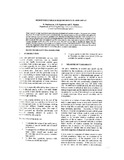| dc.contributor.author | Stephenson, D. | |
| dc.contributor.author | Kgomotso, A.K. | |
| dc.contributor.author | Matladi, T. | |
| dc.date.accessioned | 2010-10-21T13:36:52Z | |
| dc.date.available | 2010-10-21T13:36:52Z | |
| dc.date.issued | 2006 | |
| dc.identifier.citation | Stephenson, D. et al. (2006) Reservoir storage requiremens in arid areas, Botswana Journal of Technology, Vol.15, No.1, pp.13-17 | en_US |
| dc.identifier.issn | 1019 1593 | |
| dc.identifier.uri | http://hdl.handle.net/10311/625 | |
| dc.description.abstract | Water reservoir storage requirements are a function of demand and variation in inflow. The greater the variation the greater the storage required to meet a specified draft. The selected recurrence interval of failure also affects the storage required. It is found that the variation in flow increases the lower the average flow. Arid countries such as Botswana are therefore more vulnerable to drought than low mean annual flows would indicate. Rainfall and river flow records for Botswana were analyzed to produce maps that show the coefficients of variation (COV's) over the country.Examples of the use of the charts are given.The COV of river flow is significantly higher than for rainfall. This means that it is theoritically more economic to harvest rain than to attempt to store river flow. There is also less evaporation from rain tanks owing to the smaller surface area to depth ratio. However, the scale of storage also affects economics and rain harvesting affects catchment water balance. | en_US |
| dc.language.iso | en | en_US |
| dc.publisher | University of Botswana | en_US |
| dc.subject | Botswana rainfall | en_US |
| dc.subject | Rivers | en_US |
| dc.subject | Reservoirs | en_US |
| dc.subject | Storage | en_US |
| dc.title | Reservoir storage requirements in arid areas | en_US |
| dc.type | Published Article | en_US |

